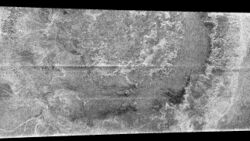Astronomy:Menrva (crater)
From HandWiki
 Cassini view of a portion of Menrva, taken on February 15, 2005 | |
| Feature type | Crater |
|---|---|
| Coordinates | [ ⚑ ] : 20°06′N 87°12′W / 20.1°N 87.2°W |
| Diameter | 392 km [1] |
| Eponym | Menrva |
Menrva is the largest crater on Titan, with a diameter of 392 kilometers.[1] The crater is a heavily eroded double ringed impact basin, similar to the impact related features of Mars and Mercury.[2] This is evident by Menrva's distinct lack of a central peak, indicating modification of the crater's surface since formation.[3] It has been estimated that Menrva is approximately 2.8 kilometers deep.
A network of channels known as Elivagar Flumina flow away from the crest of the crater into a catchment basin.[4]
The feature is named after the goddess of wisdom in Etruscan mythology, Menrva.[1]
References
- ↑ 1.0 1.1 1.2 "Menrva". USGS, NASA, IAU. http://planetarynames.wr.usgs.gov/Feature/7025. Retrieved January 17, 2016.
- ↑ Wood, Charles A. (August 28, 2009). "Impact craters on Titan". Icarus 206 (1): 334–344. doi:10.1016/j.icarus.2009.08.021. Bibcode: 2010Icar..206..334W. http://www2.ess.ucla.edu/~jewitt/class/Surfaces_Papers/Wood_10.pdf. Retrieved January 17, 2016.
- ↑ Bond, Peter (March 12, 2012). Exploring the Solar System. John Wiley and Sons. ISBN 978-1-4051-3499-6. https://books.google.com/books?id=UIYcAqdH27wC&q=menrva+crater. Retrieved January 16, 2016.
- ↑ Gilliam, A.E.; Jurdy, D.M.. "TITAN'S IMPACT CRATERS AND ASSOCIATED FLUVIAL FEATURES: EVIDENCE FOR A SUBSURFACE OCEAN?". Department of Earth and Planetary Sciences, Northwestern University. http://www.hou.usra.edu/meetings/lpsc2014/pdf/2435.pdf. Retrieved January 16, 2016.
 |


